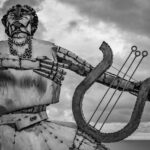Greek mythology comprises a rich tapestry of narratives that delve into the deities, heroes, and rituals of ancient Greek culture and classical antiquity. While some intellectuals, like the philosopher Plato during the 5th to 4th century BCE, acknowledged that these myths had a significant fictional component, they were generally regarded by the common populace as historically accurate representations of reality. The myths of the Greeks have had a profound impact on Western art and literature, serving as a foundation that influenced various creative expressions and philosophical ideas throughout history.
Throughout different cultures and eras, humanity has created myths to explain natural phenomena, recount heroic exploits, or validate societal or political constructs. However, Greek myths stand apart, recognized for their imaginative depth and appeal that has continued to inspire poets and artists from antiquity to modern times. Various literary and archaeological sources contribute to our understanding of these myths.
Literary Origins: Homer and Hesiod
The epic narratives attributed to Homer, specifically “The Iliad” and “The Odyssey,” are pivotal to Greek mythology. The 5th-century BCE historian Herodotus observed that Homer and Hesiod were responsible for defining the traits associated with the Olympian gods. Though today, this assertion is generally seen as metaphorical. In the opening lines of “The Iliad,” characters such as Apollo are instantly recognizable to audiences familiar with the accompanying mythological lore.
The works of Hesiod, particularly “Theogony” and “Works and Days,” further illuminate the origins of the gods and their relationships. “Theogony” is a significant text detailing the genealogies of deities and is complemented by various folktales. “Works and Days” intersperses mythic tales within a farmer’s calendar, providing wisdom on achieving success in life, with a moral emphasis on justice. These two works can be viewed as interdependent, with “Theogony” establishing divine identities and “Works and Days” providing guidance on living in accordance with those truths.
Expanding the Canon: Other Literary Contributions
In addition to Homer and Hesiod, other literary figures have enriched the mythological landscape. Fragmentary epics that followed the traditional Homeric narratives fill in gaps concerning the Trojan War. The so-called Homeric Hymns, shorter poetic works, also constitute significant resources for understanding early religious myths. Pindar, a 6th–5th century BCE lyric poet, offers a wealth of mythological content through his odes.
The tragic works of playwrights such as Aeschylus, Sophocles, and Euripides illustrate a variety of mythological traditions, showcasing the transformative power of the Greek mythos in drama and theatrical storytelling.
Hellenistic Developments and Roman Adaptations
During the Hellenistic era (323–30 BCE), poets like Callimachus compiled obscure myths. The mythographer Euhemerus introduced the idea that gods were personifications of historical figures—a theory known as Euhemerism. Apollonius of Rhodes provided crucial narratives regarding the Argonauts’ quest for the Golden Fleece, adding depth to the mythological canon.
The Roman Empire period saw additional mythological documentation, including Strabo’s geographical accounts and the writings of pseudonymous figures like the pseudo-Apollodorus and mythographers like Hyginus, offering insights into later interpretations of Greek mythology.
Archaeological Insights
The archaeological discoveries of the 19th and 20th centuries transformed our understanding of Greek mythology. Noteworthy archaeologists like Heinrich Schliemann and Sir Arthur Evans unearthed the Mycenaean and Minoan civilizations, shedding light on their mythic traditions embedded in art and ritual. The discovery of Linear B script—primarily utilized for record-keeping—limits our grasp of Mycenaean and Minoan myth and ritual to monumental findings.
Nonetheless, artifacts such as pottery from the 8th century BCE depict scenes drawn from mythic tales, including the exploits of Heracles and events related to the Trojan War. However, the abstract nature of these artistic representations complicates accurate identification and interpretation without accompanying inscriptions.
As cultures evolved through the Archaic, Classical, and Hellenistic epochs, mythological themes persisted, further enriching the corpus of Greek mythology while maintaining ties to both literary and archaeological narratives.





